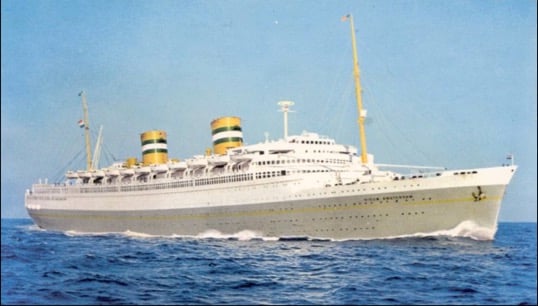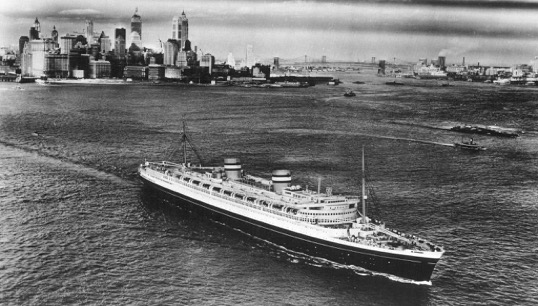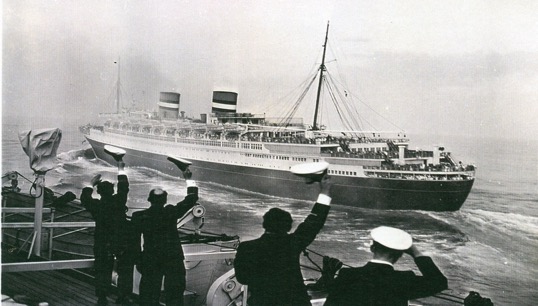Nieuw Amsterdam

The build
The Nieuw Amsterdam was built by the Rotterdam Drydock Company and was intended as a running mate for the 1929-built Statendam on the service between Rotterdam and New York.
The 32,982grt ship was powered by two sets of single reduction-geared Parsons quadruple steam turbines generating 35,100shp and driving twin screws. The 231.2m loa ship was at launch the biggest to have been built in the Netherlands.
The vessel was also designed for winter cruising. It had a service speed of 20.5 knots and achieved 22.8 knots during trials in the North Sea before the maiden voyage in May 1938.
Originally designed to carry a total of 1,220 passengers in three classes, the Nieuw Amsterdam had only completed 17 voyages before the Second World War broke out. Once requisitioned by the British Ministry of War Transport in September 1940, the Nieuw Amsterdam was converted into a troopship with a capacity of up to 8,000 personnel.
In the postwar period, the Nieuw Amsterdam went under an extensive 18-month refit in 1946. This refit included the removal of 36 guns and troop fittings and the restoration of much of the lavish original furniture and decorations which had been stored in the US during the war.
In August 1967, the ship suffered severe mechanical problems and was fitted with five new surplus US Navy boilers during a 16-week refit at the Wilton-Fijenoord yard in Schiedam.



Ownership
The Nieuw Amsterdam was built by Holland America Line and remained with the company until the Netherlands were invaded by Germany in 1940. Then it was taken over by the British Ministry of War Transport in September 1940 and run under Cunard management until it was returned to Holland America Line in October 1945.
After serving the Dutch government to repatriate personnel, the Nieuw Amsterdam returned to normal operations with Holland America Line until its end of service in 1973.
Nieuw Amsterdam Fact File
How big was the Nieuw Amsterdam?
The Nieuw Amsterdam had a grt of 32,982 and 231.2m long.
How many refits did the Nieuw Amsterdam undergo?
The Nieuw Amsterdam had two refits: one in 1946 to restore the ship back to its cruising glory, and another in August 1967 after suffering from mechanical issues.
How many troops Nieuw Amsterdam carry during WW2?
The Nieuw Amsterdam carried a total of 378,361 troops.
When did the Nieuw Amsterdam end its service?
The Nieuw Amsterdam ended its service at the end of 1973 due to its age and a fall in demand for transatlantic sea crossings.
Deployments
The Nieuw Amsterdam carried out a series of short Caribbean cruises in early 1940 before Germany invaded the Netherlands. After being requestioned by the British Ministry of War Transport in September 1940, the Nieuw Amsterdam was placed under Cunard management.
The Nieuw Amsterdam kept the Dutch flag and crew, and the ship began its new role in December 1940. Its busy war service saw the ship running – usually unescorted – between Australia and New Zealand to India, South Africa to Suez, the US and Canada to the US, and between the US and Australia and Canada. The Nieuw Amsterdam covered more than 530,452nm in this period and carried a total of 378,361 troops.
In October 1945, the Nieuw Amsterdam returned to Holland America Line and was used by the Dutch government to repatriate personnel before an eventual return to Rotterdam in April 1946.
Two years later, the Nieuw Amsterdam returned to transatlantic service and operated between Rotterdam, Le Havre, Southampton and New York, also running a winter cruise from the US to the West Indies for the next two decades.
As the North Atlantic passenger trade began to decline, the Nieuw Amsterdam was switched to full-time cruising in the Caribbean in 1971. In a bid to cut costs, Holland America Line put the Nieuw Amsterdam under the Dutch Antilles flag in September 1972.
Despite this effort to keep things going, the increasing demands of maintaining an ageing vessel resulted in a decision to withdraw it from service at the end of 1973. There were attempts to preserve the popular ship in Rotterdam as a museum, hotel and conference centre. However, this proved unsuccessful, and the Nieuw Amsterdam left Port Everglades for Taiwan to be scrapped in January 1974.
Contribute
Are you knowledgeable about this vessel?
Submit your contribution to this article to our editorial team.
Write to usView more ships of the past
HMS Beagle
Launched 200 years ago, HMS Beagle has been described as one of the most important ships in history – thanks to the observations on evolution and natural selection that its famous passenger Charles Darwin made during a five-year voyage around the world between 1831 and 1836.
Common.ReadMoreHMS Beagle
Hero
The 1977 loss of the UK-flagged ferry Hero in the North Sea sparked Union concerns over the safety of ro-ro ships a decade before the Herald of Free Enterprise disaster.
Common.ReadMoreHero
Oakleaf
Towards the end of the 1970s, the Royal Fleet Auxiliary managed to benefit from the downturn in world shipping by picking up five newly-built tankers that were laid-up after their ordering companies ran into problems.
Common.ReadMore